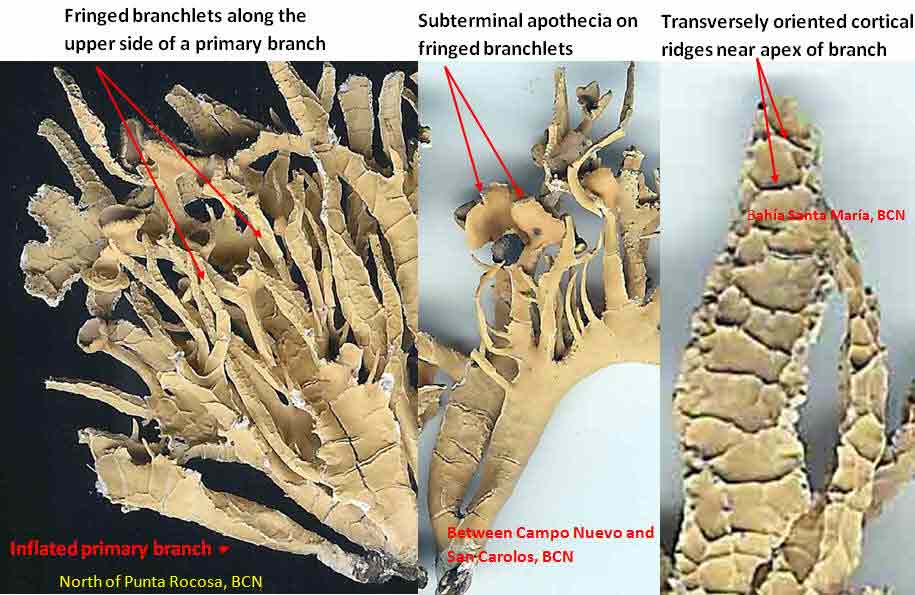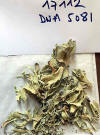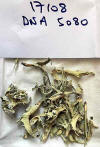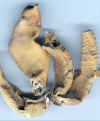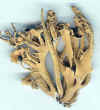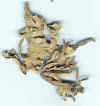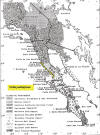|
Niebla podetiaforma is a species of fruticose lichen endemic to the Northern Vizcaíno Desert of Baja
California where it is one of the most common pebble
species of Niebla, usually occurring
on leeward slopes, ridges, and beach areas. Further away from the coast—as
Niebla
communities thin out, it appears to be the only species of a Niebla
community.
Niebla podetiaforma is easily identified by yellowish green inflated
basal branches, generally in small clumps of <20, either simple or more often
with secondary branching along the upper side of a primary arching branch.
It is distinguished from N. undulata by the
transverse ridging near apex, and by the fringed branchlets that bear apothecia,
often one to a branchlet, which may sharply curve upwards for a short distance
from where apothecia develop. The epithet was chosen for the inflated primary
branches that resemble podetia of the genus
Cladonia.
A
variant with notably inflated lobes
(Spjut 11301) is associated with other less
inflated forms (Spjut & Marin 12478, Spjut
9937) by the pattern of the transversely reticulated cortex. Another
variant with strongly flattened branches (Spjut & Marin 12681) still
exhibits
the characteristic inflated branch near the holdfast and the transversely oriented cortical ridges
near apex. These and other variants often occur in a
single dominant community of N. podetiaforma.
As indicated above
Niebla undulata
is similar to N. podetiaforma by the small tufts of less than 20
partially inflated branches arising from a pigmented holdfast. One does not actually need to count the branches;
rather, this number is generally provided as a guide in contrast to another
related species, N. turgida, that differs by its larger size and more
acutely prismatic long narrow branchlets. Niebla undulata
is usually distinguished by its cortex appearing smooth and/or recessed between
the branch margins, the color often bluish-green. Its branches are
usually undulate to below the mid region, and apothecia
often appear along the undulate margins (submarginal).
Intermediates such as shown from near El Rosario (Spjut 10332) are
referred to N. podetiaforma by the long narrow branchlets, in contrast to
the lobulate margins of N. undulata.
Two other similar
species, N. rugosa and
N. siphonoloba, are distinguished by the differences in cortical ridge patterns.
Niebla rugosa has sharply angled margins, often 3-angled in x-sect., with prominent
transverse ridges in a ladder-like arrangement connecting the longitudinal
marginal ridges, whereas N. siphonoloba (sekikaic acid) differs
slightly by the tubular
prismatic branches partial 3-angled lobes with the cortical ridges between
the margins partially reticulate.
Further south on the
Vizcaíno Peninsula and on Isla Santa Margarita one encounters
Niebla contorta. It shares features with
N. undulata in the recessed area (areoles) between the cortical ridges and submarginal development of apothecia. It differs by the relatively
straight branches near base that bear apothecia on upper undulating lobes, often
in aggregates.
Niebla podetiaforma was first
recognized in May 1985 in collecting samples of lichens for anti-HIV
screening (Spjut & Marin 9077),
while also collecting Vermilacinia cephalota (Spjut & Marin
9076) from leeward rocky slopes above Rancho San Andrés. A TLC analysis of more
than 20 thalli of Spjut & Marin 9077 proved
consistent in its lichen metabolites of divaricatic acid with triterpenes and
basal pigment (skyrin), duplicates of which
were later submitted to the Lichen Exchange at ASU. This variant is similar to
that shown for Spjut 9942, collected from a nearby slope
in May 1986.
Statistical delimitation
analyses of genomic data (Spjut et al. 2020, S5) indicate N. podetiaforma
may be associated with four different species (BPP) or just one species
(Stacey). The type was collected on remote coastal ridges between Punta
Rocosa and Punta Negra. Spjut &
Sérusiaux 17108, collected between Punta Santa Rosalillita and Punta
Rocosa, comes closest to the type locality, and morphologically is similar to
the type specimen; however, different extracts from the same packet showed
differences in the ITS phylogenetic tree by a single mutation in Group 18 in the above phylogenetic
tree. The same occurs for another species,
N. rugosa
(identified only by morphology "cf") in Groups 16 and 17, 17163A (probably
N.
contorta) and 17163B showed a difference of 4 mutations for a single collection on the Vizcaíno Peninsula
near Cerro Elephante. Phylogenetic trees in Jorna et
al. (2021) showed N. podetiaforma unresolved in a micro-clade with
N.
undulata. These studies, however, did not evaluate cryptic species,
which are common in Niebla, and which have contributed to the lack of
species resolution. Morphological differences probably need to be included
with the DNA data to more accurately delimit species boundaries.
Additional References: See
Niebla
| 